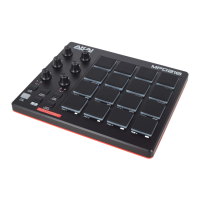regardless of how hard or softly you hit them. With pad sensitivity in mind, it is not advised to
rest your finger or hand on the pads as the slight pressure of a finger resting on the MPD's pad
can easily trigger a MIDI note. Resting on a pad can be an unconscious action so if you find that
you're double triggering notes, ensure that you are not unintentionally leaning on a pad after
striking it.
Choice of playing surface
Like the frame of an electronic drum kit in relation to the connected drum pads, the MPD's
enclosure is ultimately in contact with its trigger sensors under the pads. As a result of this
contact between the enclosure and the pads, in extreme cases, unintentional triggering can be
caused by vibrations moving through the surface on which the MPD is resting. More forceful
playing willl cause both the hardware and surface to move more and allow for a greater chance
of an unintentional trigger. The MPD's rubber feet will absorb most vibrations coming back to
the MPD's sensors but depending on the surface on which the MPD is sitting, it can pick up
latent vibrations. Put the MPD on a solid surface when you are performing. If the play surface is
unsteady or bouncy, you’re more likely to experience undesirable play characteristics such as
over-sensitivity (double triggers), or under-sensitivity (missed notes).
Working with MIDI input velocity in a DAW
In addition to the above recommendations, there are ways to filter MIDI events at the software
level. The MPD218 includes the Ableton Live 9 Lite software so for the purposes of this
demonstration we will use that software. If you are using a different DAW, check with the
software developer for more information about filtering MIDI values. Different types of MIDI
effects can be added to MIDI tracks in your Live Set. In the example below, we will be working
with a drum kit, Kit-Core 909, as our instrument. In the MIDI Effects category of Ableton,
select Velocity and add that to the Rack on the MIDI track. In Velocity's parameters, select Gate
- this parameter will allow you to choose which note velocities will register within the software
in a given range. Under the Range/Lowest fields, enter the highest and lowest possible MIDI
values. The example below shows a range of 40 to 127 - in other words, only MIDI events with a
minimum velocity of 40 will trigger the instrument.

